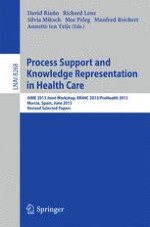2013 | Buch
Process Support and Knowledge Representation in Health Care
AIME 2013 Joint Workshop, KR4HC 2013/ProHealth 2013, Murcia, Spain, June 1, 2013, Revised Selected Papers
herausgegeben von: David Riaño, Richard Lenz, Silvia Miksch, Mor Peleg, Manfred Reichert, Annette ten Teije
Verlag: Springer International Publishing
Buchreihe : Lecture Notes in Computer Science
